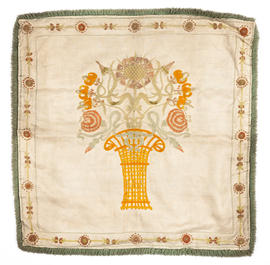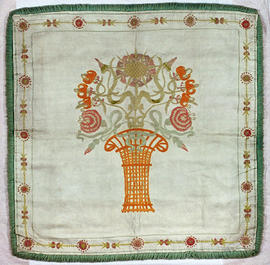Key Information
Reference code
Title
Date(s)
- c1916 (Creation)
Level of description
Item
Extent
1 item
Content and Structure
Scope and content
Scottish. Crewel work on natural linen. Basket of flowers motif, worked predominently in shades of green, orange and pink. Woollen fringe. Has label from G.S.A. Needlework Exhibition of 1916. Designed by Mrs. Newbery (Jessie Newbery). Worked by Mrs. Rowat (her aunt), Glasgow.
Appraisal, destruction and scheduling
This material has been appraised in line with Glasgow School of Art Archives and Collections standard procedures.
Accruals
System of arrangement
General Information
Name of creator
Biographical history
Jessie Wylie Newbery (1864–1948) was born in Paisley, near Glasgow, on 28 May 1864, one of the four children of William Rowat and his wife, Margaret Downie Hill. William Rowat was a shawl manufacturer and later tea importer who had strong views on the education of women. Like her father, Jessie had an independent nature. At the age of eighteen she visited Italy, where she became interested in mosaics, textiles, pottery, and ‘peasant crafts’. Throughout her life she collected textiles from Italy, Russia, and the Balkans. In 1884 she enrolled as a student at the Glasgow School of Art, and ten years later she became head of the school's department of embroidery, which she had established earlier. She married Francis H Newbery four years after his appointment as headmaster, on 28 September 1889. Her work raised the status of embroidery to that of a creative art form.
"She evolved a characteristic linen appliqué … worked on linen ground, with applied simple stylized flowers and leaves, cut out of coloured linens and held down by satin stitch in silk … the stems coiled into strong lines, outlining the shape of the article". (Swain, ‘Mrs J. R. Newbery’, 105)
She ‘liked the opposition of straight lines to curved; of horizontal to vertical … I specially aim at beautifully shaped spaces and try to make them as important as the patterns’ (ibid.). The Glasgow rose, emblem of the Glasgow style, ‘is believed to have evolved from her circles of pink linen, cut out freehand and applied with lines of satin stitch to indicate folded petals’ (ibid.). She introduced lettering, mottoes, and verses as part of her designs, and also taught needleweaving and dress design. In an interview with Gleeson White she commented, ‘I believe in education consisting of seeing the best that has been done. Then, having this high standard thus set before us, in doing what we like to do: that for our fathers, this for us’ (G. White, 48). She was a fine teacher and inspired many of her students.
At the same time Mrs Newbery managed her mercurial husband and brought up two daughters, Elsie and Mary, for whom she designed artistic yet practical dresses, as she designed and made her own attractive clothes. Her original and individual designs for dresses incorporating embroidery set a style for her students which was emulated by many of the Glasgow Girls, including the Macdonald sisters, Margaret and Frances. Like women in other artistic circles, for example, Jane and May Morris, Jessie Newbery wore dresses of an Italian Renaissance appearance, though she also believed that dress should be practical as well as beautiful. At a school at-home in November 1900:
"her black merve [sic] gown was slightly trained and had the long sleeves puffed at intervals to correspond with the simply fashioned bodice which was finished with a narrow collar of old lace, and on the shoulders bows of reddish gold velvet". (Burkhauser, 148)
It was later noted that ‘she never wore a corset in her life … she deplored the tight lacing imposed by the current fashion’ (ibid., 50), a comment that reveals her interest in rational dress (she possessed a ‘rational’ skating costume with red flannel bloomers). In 1918 she retired with her husband to Eastgate, Corfe Castle, Dorset, where she died on 27 April 1948.
Jessie's two younger sisters, Margaret (Madge) Finlayson Rowat, 1864-1948, and Mary Margaret Hill Rowat 1873-1970, also studied at the GSA. Madge appears in the Registers from 1884 to 1902 and won several local prizes for her composition, best studies of heads painted from life and heads from life in watercolour in 1890. Mary enrolled in 1897, giving her occupation as designer.
Name of creator
Biographical history
Edith Rowat appeared in the GSA registers from 1897 to 1901. Her address was given as Prospecthill, Paisley and her occupation listed as an Art Student. There are several other Rowats listed in the GSA Registers. Edith was the aunt of Jessie Wylie Newbery, nee Rowat, and embroidered the cushion cover NMC/0440 designed by her neice.
Archival history
Glasgow School of Embroidery 1894-1920';GSA;Glasgow;1916 Glasgow Museums; 1980 'Glasgow Girls'; Glasgow 1988, 1990 Crafts Council; Touring exhibition; 1992-93.
Custodial history
Physical Description and Conditions of Use
Conditions governing access
Conditions governing reproduction
Language of material
Script of material
Language and script notes
Physical Description
Dimensions: 700 x 700 x 20 mm
Finding aids
Related Material
Existence and location of originals
Existence and location of copies
Related materials
Notes area
Alternative identifier(s)
Former Reference
Keywords/Tags
Subjects
Place access points
People and Organisations
- The Needlework Development Scheme (Subject)



